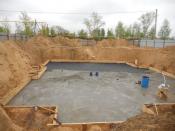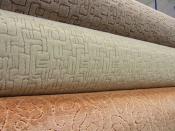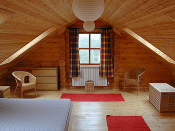Search
Login
Recommended
Polyethylene pipes, where applicable, how to choose, useful tips
Polyethylene pipes, which in modern construction often replace the usual metal ones, belong to the latest generations of plastic products. They quickly became popular and today the range of their use is quite wide; these are heating and water supply systems of various types. Moreover, experts argue that they are in fact the best alternative to tubular products from any other materials, of course - if the conditions that are acceptable for their operation are met. Often pipes made of polyethylene are abbreviated as HDPE (low pressure polyethylene) or LDPE (high pressure polyethylene), PE.
Content:
- Area of \u200b\u200buse of polyethylene pipes
- Qualities that distinguish polyethylene pipes
- Types of polyethylene pipes
- How to distinguish polyethylene pipes by marking
- LDPE
- PND
- PEX pipes - heating system made of polyethylene material video
- Installation of polyethylene pipes and its features video video
Area of \u200b\u200buse of polyethylene pipes

- Polyethylene pipes for water supply are used, i.e. trunk pipelines and systems are constructed from them for distributing water in a house or on a plot, above-ground, or being built underground.
- Due to its high performance characteristics, polyethylene products can be used in the construction of gas pipelines.
- From HDPE pipes reliable sewage systems are used that are used to drain groundwater, groundwater, and domestic sewage.
- Polyethylene pipes are used in the construction of water insulation on heating mains.
- They are indispensable in farms where plant cultivation is carried out on irrigated lands; also, with the help of pipes, a constant supply of carbon dioxide to plants is organized.
Qualities that distinguish polyethylene pipes
One of the important advantages is the ability to serve as water pipes for half a century, without changing its quality characteristics. The heating system, during the installation of which polyethylene pipes are used, is guaranteed to serve about a quarter of a century.
Attractive points for consumers are environmental friendliness and purity of the material.
Pipes can be used in residential buildings, when heated, they are not able to emit substances harmful to people, plaque or rust does not appear inside the pipes, therefore the resulting water is much cleaner than that supplied through metal pipes. Hygienists confirm that fewer pathogens are found in water obtained from polyethylene pipes.

Pipes have a smooth, attractive surface, it does not make sense to paint it during operation - it looks aesthetically pleasing for many years.
Polyethylene products are not characterized by high thermal conductivity, i.e. condensate on pipes with cold water will not collect even in hot weather.
The polyethylene pipe has a low price, it is especially lightweight and easy to install - you can do it yourself if you wish.
From PE-pipes it is possible to carry out installation of cold and hot water supply systems.
They also do not respond to chemicals.
Polyethylene pipes are flexible and flexible, moreover, they are very durable and not prone to deformation during physical impact.
Types of polyethylene pipes
Polyethylene pipes may have some differences in quality and appearance, depending on their purpose.

Pipes for gas pipelines differ in color, along the entire length of the surface of the pipe has strips, the same as the pipes designed to supply drinking water. The quality of gas pipes complies with GOST; their working pressure can be 3 to 12 atmospheres.
Pipes for technical purposes are distinguished by the presence in the material, except for polyethylene, recyclable materials, there are no GOST standards for them. Due to the low quality of the pipe material, a decrease in the quality of the welds performed when they are connected can be observed, which can lead to a deterioration in the quality of the entire structure. Technical pipes are recommended to be used for the construction of technical water supply systems and the laying of connected and electric cables.

Sewer polyethylene pipe is made of high-quality primary raw materials, its working pressure is 5 - 20 atmospheres. The area of \u200b\u200buse is the creation of pressure sewage systems.

Polyethylene pipes for water supply are easy to distinguish in appearance - longitudinal blue stripes are applied to the surface of the pipe. The parameters of such pipes comply with GOST, they are intended for the supply of drinking or industrial water. The working pressure of water pipes is from 5 to 15 atmospheres.
How to distinguish polyethylene pipes by marking

LDPE
If the marking of a polyethylene pipe contains LDPE symbols, then it is made of high-pressure polyethylene, a plastic material that is chemically inactive and has a low temperature of onset of brittleness. Such pipes are lightweight, their transportation and installation, or dismantling, do not cause special problems. They are resistant to aggressive environments, easily withstand compressive, tensile, and strain loads.
Installation is very simple, its quality allows internal sewer systems to work efficiently for decades. Working pressure in such pipes can be up to 25 atmospheres. When the substance contained in the pipe freezes, the pipe will not rupture. The recommended operating temperature is up to 40 ° C, but in an emergency the pipe can withstand temperatures of about 80 ° C.

Such pipes are characterized by chemical inertness, the technology of their production virtually eliminates the possibility of adding any foreign substances to the polyethylene mass, this allows the use of pipes in the construction of water pipes. LDPE production may vary in wall thickness and diameter, as well as in design, pipes can be:
- double-walled
- corrugated
- smooth single layer
- three-layered, reinforced synthetic threads.
PND

The letters PND indicate low pressure pipes; they are produced by polymerizing ethylene at a given temperature (150 ° C) and pressure (20 atmospheres). The resulting product has unique properties, can withstand pressure of the order of 3-5 MPa. It has a low weight, but has a strictly defined temperature range at which it can be operated from 0C to + 40C. Higher temperatures cause the material to lose ring stiffness, lower temperatures cause glazing.
An attractive point is the low rate of thermal expansion, when exposed to the maximum allowable temperatures, of the order of + 70C, the pipe will increase in size by only 3%.
Experts argue that the rational use of such pipes is:
- laying of cold water pipes with drinking or industrial water, inside structures or external, at a depth exceeding the depth of freezing of soils
- for the construction of systems for supplying gaseous substances inert to polyethylene, as well as liquid, the temperature of which is below + 40 ° C
- as boxes for electrical cables.
The possibility of operating pipes under certain conditions is influenced by the polymer grade, which determines the tolerance of internal pressure. It also forms the characteristic of HDPE pipes by the resistance of the walls.
Pressure pipes with the acronym PE are designed for water supply systems. The starting material for the manufacture of such pipes is high-quality polymer PE80 or PE100.

Corrugated polyethylene pipe is made from polyethylene raw materials marked PE63 or PE80, which is resistant to active chemicals. It is used in the construction of sewage systems. Its main feature is the presence of two layers: the upper - wave-like and the inner - exceptionally smooth. Corrugated material is used to give the product special strength, smooth - eliminates any interference with the passage of liquid and waste, such pipes are extremely rarely clogged.
PEX pipes - heating system made of polyethylene material

The unique PEX polyethylene products are particularly durable and able to operate at high temperatures; their manufacture is carried out by cross-linking polyethylene, which consists in adding molecular bonds to the structure of the material itself.
PEX pipes are characterized by:
- high density material
- resistance to high pressure and temperature, their operation is possible when using a carrier with a temperature of the order of + 90 ° C,
- when heating such a pipe, you can give any shape, after cooling the material it will remain unchanged, to return the pipe to its previous configuration, you will need to re-heat it,
- service life, during which all declared pipe qualities will be guaranteed to be preserved - about 50 years,
- light weight of pipes simplifies the process of transportation and installation, does not create unnecessary pressure on the structure of the structure,
- installation is carried out using press fittings or threaded connections, which eliminates the use of any additional equipment.

A positive point is the absence of corrosive processes in the material, small linear expansions when exposed to the maximum allowable temperatures allow the installation of heating systems inside the walls.
Features of the installation of polyethylene pipes

Installation consists in connecting fragments of polyethylene products by welding, using all kinds of fittings for polyethylene pipes.

Their installation is carried out in those places of the system where it is necessary to branch, rotate, change the diameter.

Welding is carried out using a special soldering iron, consists in melting the inside of the fitting and the surface of the pipe and quickly connecting them with subsequent cooling.
When using electric welding, the essence of the work performed remains the same, the difference lies in the presence of a device inside the fitting for melting the part.
If you use the connection option with a compression fitting, then a soldering apparatus is not required - the job is to install a special ring that will hold the connected fragments in a certain position relative to each other and prevent the possibility of destruction of the connection.





